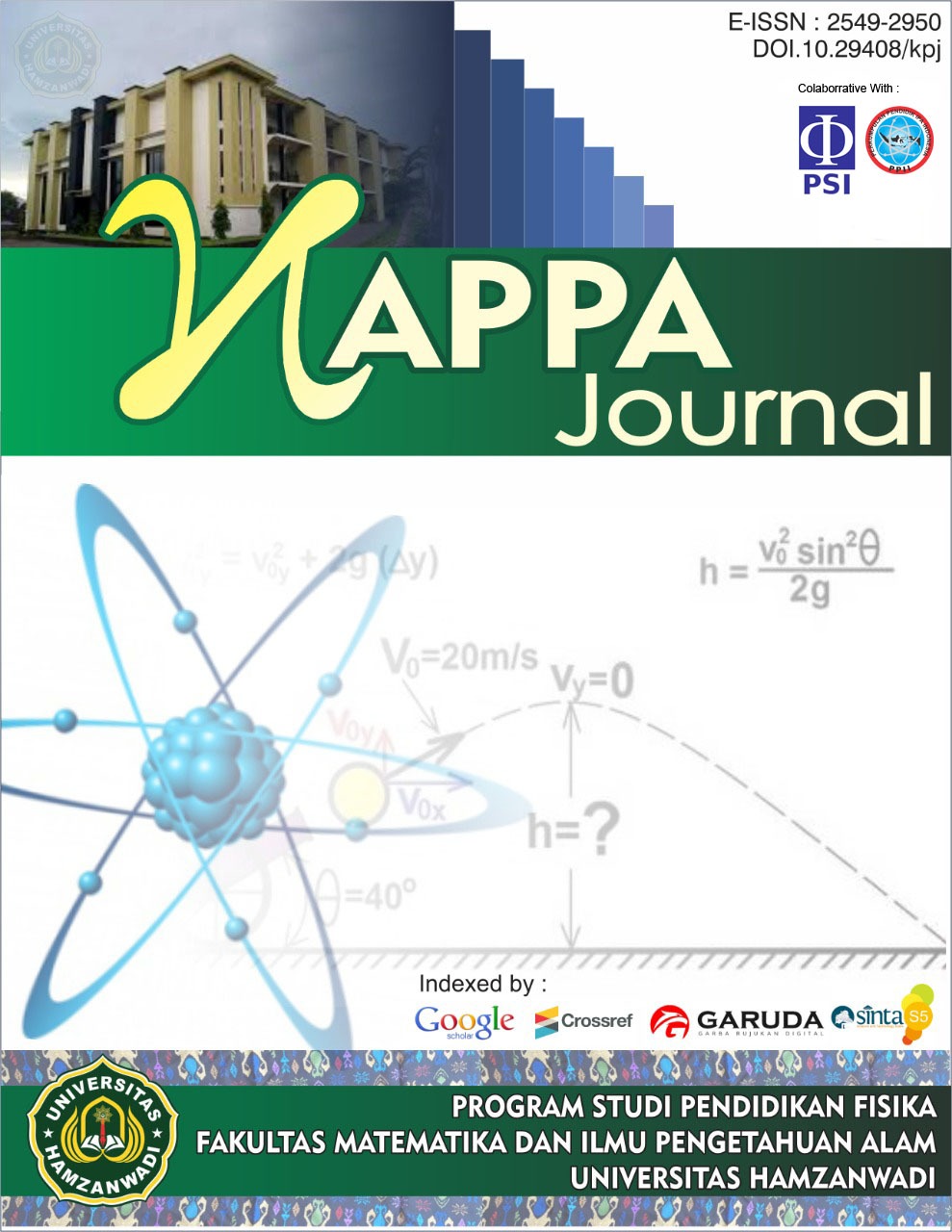Analysis of Dielectric Barrier Discharge (DBD) Plasma System with Variation Flowrate to Increase Wettability Polytetrafluoroethylene (PTFE)
DOI:
https://doi.org/10.29408/kpj.v9i1.29480Keywords:
Polytetrafluoroethylene (PTFE), Plasma, Wettability, Flow rateAbstract
Polytetrafluoroethylene (PTFE) is a widely used fluoropolymer with excellent thermal stability and chemical resistance. However, its hydrophobic nature makes it challenging to process and manage as waste. Plasma treatment is an effective method for modifying PTFE surface properties to improve wettability. This study investigates the effect of Dielectric Barrier Discharge (DBD) plasma treatment on PTFE with variations in oxygen gas flow rates. The plasma reactor was fabricated using a pyrex glass chamber, aluminum tape electrodes, and a stepper motor-driven stirring mechanism to ensure uniform exposure. PTFE samples were treated with DBD plasma at different oxygen flow rates (20–50 mL/min) for three minutes. Wettability changes were analyzed using Contact Angle Measurement (CAM), while plasma characterization was performed using Optical Emission Spectroscopy (OES). The results indicate that plasma treatment reduces the PTFE contact angle, improving its wettability. However, at higher flow rates, some samples adhered to the reactor walls, leading to uneven plasma exposure. The study concludes that plasma treatment effectively enhances PTFE wettability, but optimizing flow rate parameters is essential to ensure uniform surface modification.
References
Admadi H, B., & Arnata, IW (2015). Lecture Module 1: Polymer Technology. 1–46.
Aryanta, H., Ma, A., F, KK, & Finahari, N. (2017). Analysis of the Effect of Teflon Waste Fiber as a Substitute Material for Concrete Casting Base. Rotor Journal. 10(November), 6–11.
Baumgärtner, K. M., Schneider, J., Schulz, A., Feichtinger, J., & Walker, M. (2001). Short-time plasma pre-treatment of polytetrafluoroethylene for improved adhesion. Surface and Coatings Technology, 142–144, 501–506. https://doi.org/10.1016/S0257-8972(01)01209-9
Fan, Z., Di, L., Zhang, X., & Wang, H. (2019). A surface dielectric barrier discharge plasma for preparing cotton-fabric-supported silver nanoparticles. Nanomaterials, 9(7). https://doi.org/10.3390/nano9070961
Fitriani, SW, Santjojo, DJDH, Masruroh, Sakti, SP, & Aizawa, T. (2018). Micro-texturing into DLC coating on the SKD11 die via the high-density plasma oxidation. Proceedings - 12th SEATUC Symposium, SEATUC 2018, 11–15. https://doi.org/10.1109/SEATUC.2018.8788882
Fried, J.R. (2014). Polymer Science & Technology. In Prentice Hall.
Gomes, DJC, De Souza, N.C., & Silva, J.R. (2013). Using a monocular optical microscope to assemble a wetting contact angle analyzer. Measurement: Journal of the International Measurement Confederation, 46(9), 3623–3627. https://doi.org/10.1016/j.measurement.2013.07.010
Iqbal, M., Dinh, D. K., Abbas, Q., Imran, M., Sattar, H., & Ul Ahmad, A. (2019). Controlled Surface Wettability by Plasma Polymer Surface Modification. Surfaces, 2(2), 349–371. https://doi.org/10.3390/surfaces2020026
Istiqomah, Nur, M., & Arianto, F. (2017). Characterization of a dielectric barrier discharge plasma reactor with a spiral-cylinder electrode configuration with a free air source. Youngster Physics Journal, 6(3), 235–241.
Kalin, M., & Polajnar, M. (2014). The wetting of steel, DLC coatings, ceramics and polymers with oils and water: The importance and correlations of surface energy, surface tension, contact angle and spreading. Applied Surface Science, 293, 97–108. https://doi.org/10.1016/j.apsusc.2013.12.109
Kasa, RA, Juswono, UP, & Santjojo, DJDH (2022). Identification of Reactive Species Produced by Surfaces Dielectric Barrier Discharge Nonthermal Plasma with Gas Sources Variation (Air, N2, O2) to Kill Bacteria. Journal of Science Education Research, 8(4), 2371–2377. https://doi.org/10.29303/jppipa.v8i4.2167
Li X., Lu F., Cocca M., Vega K., Fleischer A., Bailey A., Toro M., Sachdev S., Debies T. Gupta, S., & Takacs, G. (2018). Surface Modification of Polystyrene with O Atoms Produced Downstream from an Ar/O2 Microwave Plasma. Technologies, 6(1), 21. https://doi.org/10.3390/technologies6010021
Marmur, A. (2006). Soft contact: Measurement and interpretation of contact angles. Soft Matter, 2(1), 12–17. https://doi.org/10.1039/b514811c
Moreau, E., Debien, A., Bénard, N., Jukes, T., Whalley, R., Choi, K., Berendt, A., Podliński, J., & Mizeraczyk, J. (2013). Surface Dielectric Barrier Discharge Plasma Actuators. ERCOFTAC Bulletin, 94, 5–10. http://www.ercoftac.org/downloads/sig20/actuators_moreau.pdf/
Nasution, TPK and J. (2016). Development of Cold Plasma Technology for Modifying Material Surface Characteristics Without Changing the Basic Properties of the Material. PASTI Journal, X(3), 1–23.
Prasetyo, T., Berahim, H., & T, H. (2012). 151162-ID-pengujian-sudut-kontak-pada-bahan-isolas.pdf. In Testing Contact Angles on Epoxy Resin Insulation Materials with Beach Sand Filler Containing High Calcium (Vol. 5, pp. 55–63).
Rachdi, L., Sushkov, V., & Hofmann, M. (2022). Optical emission spectroscopy diagnostics for plasma parameters investigation in a Duo-Plasmaline surface-wave sustained discharge. Spectrochimica Acta - Part B Atomic Spectroscopy, 194(July 2021), 106432. https://doi.org/10.1016/j.sab.2022.106432
Radulovic, L.L., & Wojcinski, Z.W. (2014). PTFE (Polytetrafluoroethylene; Teflon®). In Encyclopedia of Toxicology: Third Edition (Third Edit, Vol. 3). Elsevier. https://doi.org/10.1016/B978-0-12-386454-3.00970-2
Rezaei, F., Abbasi-Firouzjah, M., & Shokri, B. (2014). Investigation of antibacterial and wettability behaviors of plasma-modified PMMA films for applications in ophthalmology. Journal of Physics D: Applied Physics, 47(8). https://doi.org/10.1088/0022-3727/47/8/085401
Wolf, R., & Sparavigna, A. C. (2010). Role of Plasma Surface Treatments on Wetting and Adhesion. Engineering, 02(06), 397–402. https://doi.org/10.4236/eng.2010.26052
Downloads
Published
Issue
Section
License
Copyright (c) 2025 Kappa Journal

This work is licensed under a Creative Commons Attribution-ShareAlike 4.0 International License.
Semua tulisan pada jurnal ini menjadi tanggungjawab penuh penulis. Jurnal Kappa memberikan akses terbuka terhadap siapapun agar informasi dan temuan pada artikel tersebut bermanfaat bagi semua orang. Jurnal Kappa dapat diakses dan diunduh secara gratis, tanpa dipungut biaya, sesuai dengan lisensi creative commons yang digunakan








